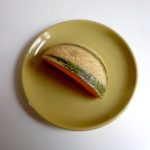 When the French say melon, they are generally referring to one particular type of melon. It is small and round, about 4-6 inches (10-15 cm) in diameter, with dark green stripes over a pale exterior and an intoxicatingly sweet orange interior. It is similar to cantaloupe, but more fragrant. The most highly reputed come from Cavaillon, in Provence, while the most widely sold are called Charentais. All pair delightfully with duck.
When the French say melon, they are generally referring to one particular type of melon. It is small and round, about 4-6 inches (10-15 cm) in diameter, with dark green stripes over a pale exterior and an intoxicatingly sweet orange interior. It is similar to cantaloupe, but more fragrant. The most highly reputed come from Cavaillon, in Provence, while the most widely sold are called Charentais. All pair delightfully with duck.
Assiette de canard et melon / Duck and melon plate
The season for melon (pronounced muh-LOH, with a nasal twang at the end) begins in July and runs into the autumn, so we were in mid-season last weekend when I created this dish. A friend and I were spending a couple of sultry days in the Burgundy countryside. We had grilled a duck breast on the barbecue the evening before, and there was enough left over to compose a lovely plate. The melon perfectly complemented the duck.
The combination is not encountered frequently here. Melon is most often paired with cured ham, for example jambon de Bayonne, from the southwest, or prosciutto, imported from Italy. In decades past, another common starter was melon au porto — the melon was cut in half, and the cavity was filled with sweet port wine. This has faded from fashion, which is a shame because it was fantastic (watch this space).
 It is a mystery why the melons over here are so much sweeter than those found in the States. Perhaps because the sun in southern France is more intense, or maybe there’s another reason. If you have an idea, please let us know.
It is a mystery why the melons over here are so much sweeter than those found in the States. Perhaps because the sun in southern France is more intense, or maybe there’s another reason. If you have an idea, please let us know.
Meantime, here’s something that may interest readers in Paris. A friend of mine, the author Ann Mah, is sponsoring an event called Food Lovers For Hillary that will be held from 3 to 6 p.m. on Sunday, Sept. 18. Major stars of the culinary firmament will be in attendance — Patricia Wells, David Lebovitz, Alexander Lobrano and Dorie Greenspan. Each will offer a prize, such as a cooking class or a market tour, to be bid for in a silent auction. The aim of the event is to raise money for Hillary Clinton, so the price of entry is a $100 donation. It is, in the opinion of this everyday French chef, a worthy cause.
Happy cooking!





Yesterday I bought a Charentais melon at the marché in the 15th. My favorite marchand assured me that it would be perfect for tonight’s late supper. It was. And paired with the duck breast, vinaigrette and arugula-delicious! We toasted you with a glass of rosé, Meg.
Thank you for the great recipe. Definitely a meal to repeat. Hope your vacation is brilliant!
Thank you, Brenda! That’s great to hear.
Hi Meg,
Here in southwest France we eat our melons with a splash of Pineau des Charentes, but we were in the Champagne area last week and were served our melon with Ratafia, a local aperitif made from champagne grape leftovers. I also make a chilled melon soup with a dash of vodka for hot summer days. Can’t get enough of these melons.
Hi Kerrie. Melon with ratafia sounds very interesting. I actually made ratafia once, from freshly squeezed apple juice, but I believe it is more often made from grapes. Will post the recipe one of these days. Meantime I just arrived in the southwest yesterday for a week at the beach. Melon with Pineau des Charentes? Will definitely try that! Best, Meg
I’ve often grown Charentais melons in my home garden. They are a little difficult to deal with, because they seem to turn suddenly from under- to overripe. When I was last in Paris, the street market was full of Charentais melons, all apparently underripe. I wondered, do the French really like them so green? While I contemplated buying one anyway a man walked up beside me, brought a melon to his nose, put it down with a snort, and walked away. So the answer is no; the French prefer them ripe!
Well, this is interesting! That makes two of you who have encountered/raised Charentais melons in the States. I was not aware they had crossed the Atlantic. More on this subject later. Am about to get on a train — to the Basque country.
I think there are two primary reasons for the prevalence of melons that lack sweetness and fragrance in the US. The primary reason is that they’re picked too soon, and the second reason is that the varieties are developed for shipping and storage, not sweetness and flavor. Having said that, I often get wonderful melons at the farmers’ market. Just two weeks ago we enjoyed a delicious Charentais variety.
Joyce, many thanks for the explanation. And I’m glad to hear that Charentais melons are available Stateside now. Cheers, Meg